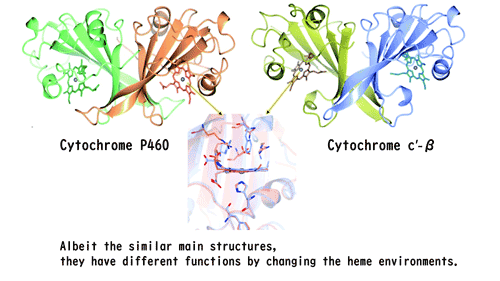Highlights
○ A multiple research team from Essex University, Oregon University, and Hiroshima University identified that cytochromes P460 and c’ from Methylococcus capsulatus (Bath) conserves similar overall structures.
○ Albeit the similar structures of these cytochromes, they shows different types of functions by changing the heme environments.
○ There results provide insights relevant to enzyme redesign for synthetic enzymology and engineering of proteins.
Overview
Nature is adept at utilising highly similar protein folds to carry out very different functions, yet the mechanisms by which this functional divergence occurs remain poorly characterised. In certain methanotrophic bacteria, two homologous pentacoordinate c-type heme proteins have been identified: a cytochrome P460 (cyt P460) and a cytochrome c’-β(cyt cp-β). Cytochromes P460 are able to convert hydroxylamine to nitrite and/or N2O, the latter being a potent greenhouse gas. This reactivity is similar to that of hydroxylamine oxidoreductase (HAO) is a key enzyme in anammox and occurs in methanotrophic bacteria. Cyt P460 and HAO both have unusual protein-heme crosslinks, formed by a Tyr residue in HAO and a Lys in cyt P460. In contrast, cyt cp-β (the only known cytochromes c’ with a β-sheet fold) lacks this crosslink and appears to be optimized for binding smaller non-polar molecules (including NO and CO) without enzymatic conversion.
Our bioinformatics analysis supports the proposal that cyt cpβ may have evolved from cyt P460 via a gene duplication event. Using high-resolution X-ray crystallography, UV-visible absorption and resonance Raman spectroscopy, we have characterized the overall protein folding and active site structures of cyt cp-βand cyt P460 from the obligate methanotroph, Methylococcus capsulatus (Bath). These proteins display a similar β-sheet protein fold, together with a pattern of changes to the heme pocket regions and localised tertiary structure that have converted a hydroxylamine oxidizing enzyme into a gas-binding protein.
Structural comparisons provide insights relevant to enzyme redesign for synthetic enzymology and engineering of gas sensor proteins. We also show the widespread occurrence of cyts cp-β and characterise their phylogeny.
Full bibliographic information
Journal: Chemical Science
Title: One fold, two functions: cytochrome P460 and cytochrome c'-β from the methanotroph Methylococcus capsulatus (Bath).
Authors: Hannah R. Adams1, Callie Krewson2, Jenny E. Vardanega2, Sotaro Fujii3, Tadeo Moreno Chicano1, Yoshihiro Sambongi3, Dimitri Svistunenko1, Jordi Paps1, Colin R. Andrew2 and Michael A. Hough1.
1. School of Biological Sciences, University of Essex, Wivenhoe Park, Colchester, Essex CO4 3SQ, UK .
2. Department of Chemistry and Biochemistry, Eastern Oregon University, La Grande, Oregon 97850, USA.
3. Graduate School of Biosphere Science, Hiroshima University, Kagamiyama 1-4-4, Higashi-Hiroshima, Hiroshima, 739-8528, Japan.
DOI: 10.1039/c8sc05210g.
The overall structures of cytochromes P460 and cp-β, and the superimposition of the heme environments in cytochromes P460 and cp-β.
Yoshihiro SAMBONGI
Professor, Graduate School of Integrated Sciences for Life, Hiroshima University
E-mail: sambongi*hiroshima-u.ac.jp (Please change * into @)
Sotaro FUJII
Assistant Professor, Graduate School of Integrated Sciences for Life, Hiroshima University
E-mail: sofuji*hiroshima-u.ac.jp (Please change * into @)

 Home
Home








